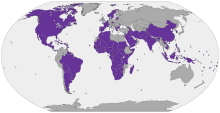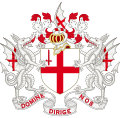Motto
A motto (derived from the
Language
- South Cambridgeshire in the English Fens: Niet Zonder Arbyt (Nothing without work), Dutch, originally the motto of Dutchman Cornelius Vermuyden, who drained The Fens in the 17th century.[7][8]
- South Africa: ǃke e: ǀxarra ǁke (Unity in diversity), ǀXam.
- Shire of Shetland: Með lögum skal land byggja (By law shall the land be built up), Old Norse.[9]
A canting motto is one that contains word play.[10] For example, the motto of the Earl of Onslow is Festina lente (literally 'make haste slowly'), punningly interpreting 'on slow'.[11] Similarly, the motto of the Burgh of Tayport, Te oportet alte ferri (It is incumbent on you to carry yourself high), is a cant on 'Tayport at auld Tay Ferry', also alluding to the local lighthouse.[12] The motto of the U.S. Federal Bureau of Investigation, Fidelity, Bravery, Integrity, is a backronym of the letters F.B.I.
List of examples

- United in diversity, the motto of the European Union (EU)
- In God We Trust, the motto of the United States (US)
- Je Maintiendrai Je maintiendrai (French for "I will maintain"), the motto of the Netherlands
- Dieu et mon droit (French for "God and my right"), is the motto of the monarch of the United Kingdom. It appears on a scroll beneath the shield of the version of the coat of arms of the United Kingdom.
- Unus pro omnibus, omnes pro uno (Latin for "One for all, all for one"), unofficial motto of Switzerland
- Post tenebras lux (Latin for "Light After Darkness"), motto of University of Geneva
- United we stand, divided we fall[clarification needed]
Mottos in heraldry
| Part of a series on |
| Heraldic achievement |
|---|
| External devices in addition to the central coat of arms |
|
t |
In heraldry, a motto is often found below the shield in a banderole in the compartment. This placement stems from the Middle Ages, in which the vast majority of nobles possessed a coat of arms complete with a motto. In the case of Scottish heraldry, it is mandated to appear above the crest[13] and is called slogan (see: Slogan (heraldry)). The word 'slogan' is an Anglicisation of the Scottish Gaelic sluagh-ghairm (sluagh "army, host" + gairm "cry").[14] There are several notable slogans which are thought to originate from a battle or war cries. In heraldic literature, the terms 'rallying cry' respectively 'battle banner' are also common.[citation needed] Spanish coats of arms may display a motto in the bordure of the shield.[15]
In English heraldry, mottos are not granted with armorial bearings, and may be adopted and changed at will. In Scottish heraldry, mottos can only be changed by re-matriculation, with the Lord Lyon King of Arms.[16] Although unusual in England, and perhaps outside English heraldic practice, there are some examples, such as in Belgium, of the particular appearance of the motto scroll and letters thereon being blazoned;[17] a prominent example is the obverse of the Great Seal of the United States (which is a coat of arms and follows heraldic conventions), the blazon for which specifies that the motto scroll is held in the beak of the bald eagle serving as the escutcheon's supporter.
-
Motto "Domine dirige nos" (Coat of arms of the City of London
-
Above the crest is the slogan (see:war cry, Arms of Brady Brim-DeForest, Baron of Balvaird
Mottos in literature
In literature, a motto is a sentence, phrase, poem, or word; prefixed to an essay, chapter, novel, or the like, suggestive of its subject matter. It is a short, suggestive expression of a guiding principle for the written material that follows.[4]
For example, Robert Louis Stevenson's Travels with a Donkey in the Cévennes uses mottos at the start of each section.[20]
See also
- Epigram
- Epitaph
- Hendiatris
- List of Latin phrases
- List of mottos
- List of national mottos
- Mission statement
- Slogan
- Tagline
References
- ^ a b c motto – Cambridge Dictionary. Cambridge, England: Cambridge University Press. 2022. Retrieved 1 November 2022.
{{cite encyclopedia}}:|website=ignored (help) - ^ a b "motto – Oxford Dictionaries". OxfordDictionaries.com. Oxford, England: Oxford University Press. Archived from the original on 18 August 2016. Retrieved 31 January 2011.
- ^ motto – Merriam-Webster. Merriam-Webster, Incorporated. 2022. Retrieved 1 November 2022.
{{cite encyclopedia}}:|website=ignored (help) - ^ a b c "Webster's Revised Unabridged Dictionary (1913)". The ARTFL Project. The University of Chicago. Archived from the original on 6 December 2013. Retrieved 20 December 2013. [failed verification]
- Somerset County Council archives. Archived from the originalon 24 December 2013. Retrieved 26 June 2015.
- ^ "Somerset - Coat of arms (crest) of Somerset". Heraldry-Wiki.com. Heraldry of the World. 19 March 2019. Retrieved 1 November 2022.
- ^ "Civic Heraldry of England and Wales – East Anglia and Essex area". CivicHeraldry.co.uk. Archived from the original on 28 August 2009. Retrieved 8 November 2009.
- ^ "South Cambridgeshire". rsnonline.org.uk. Rural Services Network. Archived from the original on 24 December 2013. Retrieved 21 December 2013.
- ^ "Shetland Islands - Coat of arms (crest) of Shetland Islands". Heraldry-Wiki.com. Heraldry of the World. 13 October 2020. Archived from the original on 26 May 2021. Retrieved 1 November 2022.
- OL 24349702M. Retrieved 1 November 2022.
- ISBN 9780788404566.
- ^ "Tayport - Coat of arms (crest) of Tayport". Heraldry-Wiki.com. Heraldry of the World. 13 October 2020. Retrieved 1 November 2022.
- OL 7944413M.
- ^ "slogan". Merriam-Webster. 2003. p. 1174.
- OL 7944413M.
- OCLC 1036776100. Retrieved 1 November 2022.
Mottos are not necessarily hereditary, and can be adopted and changed at will.
- ^ "USS Winston S. Churchill (DDG-81)". The Institute of Heraldry. Retrieved 21 February 2024.
- ^ "Juhana Herttuan patsas - Pori, Finland – Statues of historic figures". Waymarking.com. Groundspeak, Inc. 2022. Retrieved 1 November 2022.
- ^ Cassells, Vic (2000). The capital ships: Their battles and their badges. Kangaroo Press. p. 190.
- ^ Stevenson, Robert Louis (1907). Travels with a Donkey in the Cevennes. London, England: Chatto & Windus.



![Motto Deus protector noster (Latin for 'God is our protector') below the arms of Pori[18]](http://upload.wikimedia.org/wikipedia/commons/thumb/c/cb/Porin_vaakuna.svg/102px-Porin_vaakuna.svg.png)
